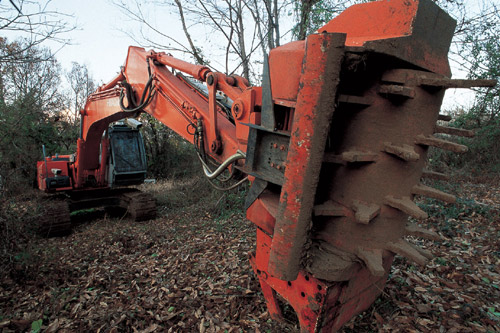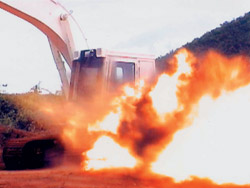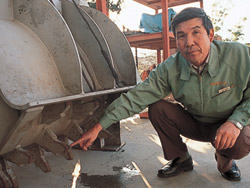|
NIPPONIA No.20 March 15, 2002
|
|
Special Feature*
Japanese Technology Makes the World a Better Place
During the 20th century, technology made life more convenient and affluent. But technology has created its own problems, such as pollution of the global environment. Japan is developing new technologies that will help us use our planet's resources more wisely and achieve true affluence.
Written by Torikai Shin-ichi, Photos by Kono Toshihiko
Other photo credits: Yamanashi Hitachi Construction Machinery Co., Ltd.; Toyama Masao; Kyoto City
Transforming Dangerous Minefields into Valuable Farmland
Yamanashi Hitachi Construction Machinery Co., Ltd.
 |
|
Every hour, this landmine destroyer can zap mines in areas ranging from 400 to 700 m2. It can also pulverize tree trunks measuring up to 30 cm in diameter.
|
Anti-personnel landmines are the tragic remnants of war. The world needs new types of machines to deactivate landmines, and a company called Yamanashi Hitachi Construction Machinery began developing one in 1995.
The company president, Amemiya Kiyoshi, says, "Experts estimate that well over 100 million anti-personnel mines remain in the ground in different parts of the world. When I heard that, I realized that even if people tried to get rid of them all by hand, many would still be in the ground years from now. So I thought, if other companies aren't going to find a solution, my company will." This decision led to the development of an innovative mine deactivation system.
Minefields generally become wasteland, and in time they are covered by bushes and tall weeds. Then mine removal is even more difficult. So Amemiya decided to develop a machine that could destroy mines and prepare the ground for farming at the same time.
They started with a large backhoe, and attached a fast-moving rotary cutter to it. The cutter blades mash the bushes, small stones and even the mines into small pieces, tilling the ground as the machine moves forward.
"During the development stage, the most difficult job was finding an ideal material for the blades and attaching them to the cutter so that they would not fly off when a mine detonated," Amemiya says.
The blades also had to be made so that they wouldn't break or chip easily. After five years of research, the company came up with a super alloy for the blades. The alloy has two seemingly contradictory properties—it is hard and soft at the same time. The company also developed a way to attach the blades so that the joints can withstand temperatures as high as 1000°C when a mine detonates.
Amemiya's machines are currently clearing minefields in Cambodia, Afghanistan and Nicaragua.
 |
 |
 |
|
Destroying anti-personnel landmines in Cambodia.
|
Amemiya Kiyoshi says his company used a combination of technologies to develop the rotary cutter teeth.
|
|